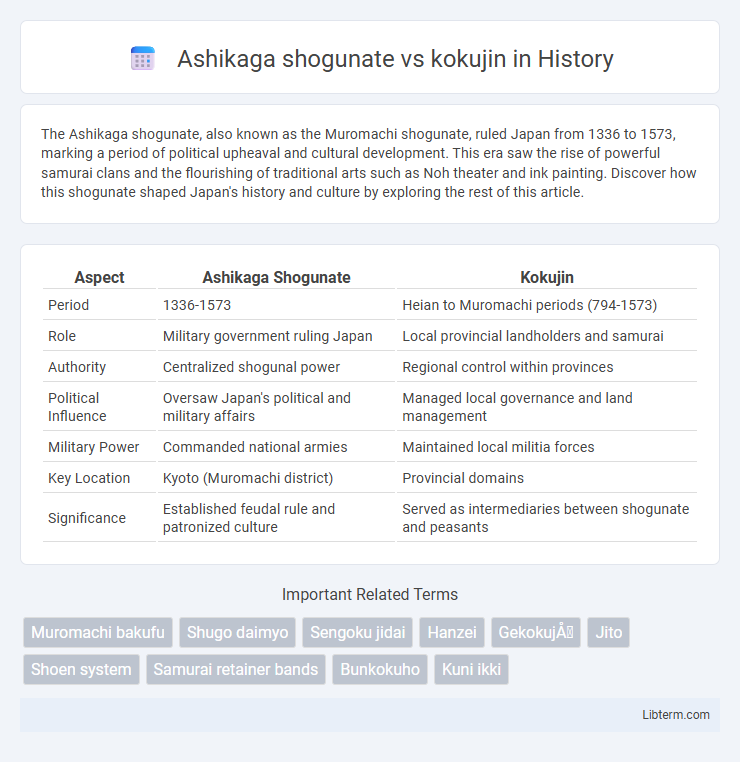The Ashikaga shogunate, also known as the Muromachi shogunate, ruled Japan from 1336 to 1573, marking a period of political upheaval and cultural development. This era saw the rise of powerful samurai clans and the flourishing of traditional arts such as Noh theater and ink painting. Discover how this shogunate shaped Japan's history and culture by exploring the rest of this article.
Table of Comparison
| Aspect | Ashikaga Shogunate | Kokujin |
|---|---|---|
| Period | 1336-1573 | Heian to Muromachi periods (794-1573) |
| Role | Military government ruling Japan | Local provincial landholders and samurai |
| Authority | Centralized shogunal power | Regional control within provinces |
| Political Influence | Oversaw Japan's political and military affairs | Managed local governance and land management |
| Military Power | Commanded national armies | Maintained local militia forces |
| Key Location | Kyoto (Muromachi district) | Provincial domains |
| Significance | Established feudal rule and patronized culture | Served as intermediaries between shogunate and peasants |
Origins of the Ashikaga Shogunate
The Ashikaga Shogunate originated in 1336 when Ashikaga Takauji established military rule after overthrowing the Kamakura Shogunate, signaling a power shift from the central government to regional warrior lords known as kokujin. These kokujin were local samurai landholders who exercised significant autonomous control over their territories, often challenging the Ashikaga's authority. The resulting dynamic between the Ashikaga Shogunate and kokujin shaped the decentralized feudal structure of Muromachi Japan.
Rise and Role of the Kokujin
The Ashikaga shogunate's establishment during the Muromachi period marked a decentralization of power, enabling the rise of the kokujin--local samurai landholders who gained significant influence by managing rural estates and military forces. Kokujin played a crucial role in maintaining regional order and supporting the shogunate's authority, often acting as intermediaries between central government and peasant communities. Their growing autonomy and military strength eventually contributed to the fragmentation of political power, setting the stage for the Sengoku period's widespread conflicts.
Political Structure of the Muromachi Era
The Ashikaga shogunate centralized military power while relying on a decentralized coalition of kokujin, powerful regional landholders who controlled local domains in the Muromachi era. Political authority was fragmented but balanced through a system called shugo-daimyo, where kokujin served as military governors under shogunal oversight yet maintained significant autonomy. This structure created a complex feudal network that defined Muromachi governance and contributed to both stability and internal conflict.
Relationships Between Shogunate and Kokujin
The Ashikaga shogunate maintained a complex relationship with the kokujin, local landholders and military governors, balancing centralized authority with regional autonomy. Kokujin played a critical role in governing provinces by collecting taxes and enforcing law, but often acted independently, challenging shogunate control. Efforts to integrate kokujin into the shogunate's power structure included appointments and land grants to secure their loyalty while managing frequent conflicts and shifting alliances.
Conflicts and Power Struggles
The Ashikaga shogunate faced persistent conflicts with the kokujin, regional samurai lords who challenged its authority during the Muromachi period. Power struggles between the central government and kokujin involved territorial disputes, military rebellions, and shifting alliances that weakened Ashikaga control. These clashes contributed to the decentralization of political power and set the stage for the Sengoku period's widespread civil wars.
Economic Control and Land Management
The Ashikaga shogunate exercised economic control by regulating trade and assigning land rights, but its power was often undermined by kokujin, local samurai leaders who controlled rural estates and collected taxes independently. Kokujin managed land through hereditary ownership and maintained private armies, enabling them to resist shogunate interference and administer local agriculture and commerce autonomously. This decentralized land management created a fragmented economic system where kokujin held significant regional influence despite nominal allegiance to Ashikaga authority.
Military Alliances and Feuds
The Ashikaga shogunate relied heavily on strategic military alliances with regional kokujin, local samurai lords who controlled significant territories, to maintain power during the Muromachi period. These alliances were frequently fragile as kokujin often harbored ambitions of autonomy, leading to recurrent feuds and internal conflicts that weakened central authority. Notable rivalries, such as those involving the Hosokawa and Yamana clans, exemplify the shifting loyalties and violent contests that shaped the political and military landscape under Ashikaga rule.
Impact on Regional Governance
The Ashikaga shogunate's reliance on kokujin, or regional landowners, significantly shaped local governance by decentralizing power and fostering semi-autonomous domains. Kokujin exercised judicial and military authority within their territories, creating a fragmented political landscape and challenging the shogunate's central control. This dynamic contributed to prolonged regional conflicts and the eventual rise of warlord autonomy during the Muromachi period.
Decline of Central Authority
The Ashikaga shogunate faced significant challenges from kokujin, local samurai lords who increasingly undermined central authority through autonomous control over their territories. This decentralization led to weakened governance as kokujin prioritized regional power and military strength, decreasing the shogunate's influence. The resulting fragmentation contributed to the decline of centralized political order during the late Muromachi period.
Legacy in Japanese Feudal History
The Ashikaga shogunate established a centralized military government that significantly influenced the power dynamics between the shogun and kokujin, or local samurai lords, reshaping feudal governance in medieval Japan. This era marked a shift towards decentralization as kokujin gained increased autonomy, fostering regional political fragmentation that set the stage for the Sengoku period's widespread conflict. The legacy of the Ashikaga shogunate lies in its transformation of feudal hierarchy, altering the balance of power and contributing to the evolving structure of Japanese feudal society.
Ashikaga shogunate Infographic

 libterm.com
libterm.com